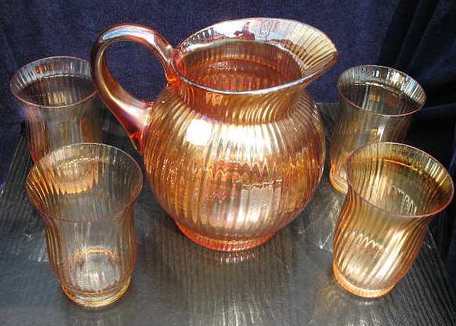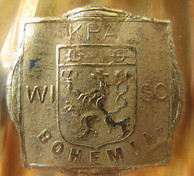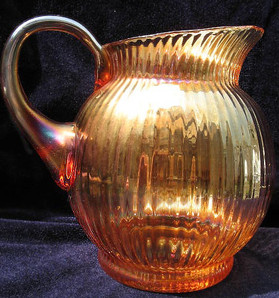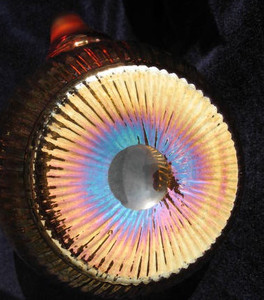The Kralik Discovery
This delightful marigold water set was found by Della Breukelaar. She named the pattern "Thistlewood Rib" (we are honoured by Della's thoughtfulness).
The pitcher is mould blown, with an applied handle, and has the similar, bulbous "cannonball" shape that many USA Classic Carnival Glass water pitchers have. The shape of the item - the neck is narrower than its body - prohibited the use of a plunger. Thus the glass had been blown into a mould (not pressed). The pattern on the water set is a simple but effective vertical ribbed design that enhances the marigold iridescence to full effect.
So, who made it?
It's not a pattern we had seen before, but the answer undoubtedly lay in a golden paper label that graced the exterior of the jug (see below, right).
The pitcher is mould blown, with an applied handle, and has the similar, bulbous "cannonball" shape that many USA Classic Carnival Glass water pitchers have. The shape of the item - the neck is narrower than its body - prohibited the use of a plunger. Thus the glass had been blown into a mould (not pressed). The pattern on the water set is a simple but effective vertical ribbed design that enhances the marigold iridescence to full effect.
So, who made it?
It's not a pattern we had seen before, but the answer undoubtedly lay in a golden paper label that graced the exterior of the jug (see below, right).
|
Our study of the label gave us an answer that rocked the Carnival boat, in much the same way as our discovery that Rindskopf was also a Carnival Glass maker. For the golden paper label pointed us to Kralik - the famous Czech Art Glass manufacturer. The lion holding an urn features on the trademark of Eleonorahutte aka Eleonora Glassworks, "one of the most highly regarded of all Bohemian glassworks" (Foulds*). The lion on Della's golden label is identical - and the word BOHEMIA adds to the clues.
However, the final decider as to provenance are the letters WI KRA SO - these represent the name of the factory: Wilhelm Kralik Sohne. |
Wilhelm Kralik Sohne, Eleonora Glassworks, Bohemia
In 1833-34, Johann Meyr (son of Josef Meyr) built a glass works by the Vltava River, at the foot of Mount Boubin in southern Bohemia and called it Eleonorahutte. The factory passed on first to Meyr's nephews (Wilhelm Kralik and Josef Taschek) and then later, in 1877, to two of Wilhelm Kralik's sons - who changed the name to Wilhelm Kralik Sohne (Wilhelm Kralik's Sons) and produced high quality glass. In the words of Robert & Deborah Truitt* their output "covered the entire spectrum of Art Nouveau designs: iridized, painted, hot decorated, cut and engraved".
Diane Foulds* notes that "the company prospered into the 1930s by exporting household glass in various price ranges within Europe and also to the Americas, despite the worldwide Depression."
In 1946 the company was nationalised and merged with Cesky Kristal, which became part of Cristalex. In 1995 the glassworks at Eleonora was closed down.
Czech glass researcher Marcus Newhall, has added the following important information about the Lenora factory. He notes that the company originally had factories at Vimperk, (CZ) Kaltenbach, Franzensthal, Ernstbrunn (Austria) and Luicina. The Vimperk works became part of Moser after World War I. Only Lenora appears to have stayed under Kralik family control during the inter-war period.
So, we can now add Kralik to both Rindskopf and Inwald, on the list of Czech glass makers who produced Carnival Glass. It is very possible that other Carnival items were also made by Kralik, and are currently going un-attributed. This major discovery is all thanks to a little golden label on Della's splendid water set.
If you have any comments or corrections, or if you want to add any information, please email us. All information used here will be fully acknowledged.
In 1833-34, Johann Meyr (son of Josef Meyr) built a glass works by the Vltava River, at the foot of Mount Boubin in southern Bohemia and called it Eleonorahutte. The factory passed on first to Meyr's nephews (Wilhelm Kralik and Josef Taschek) and then later, in 1877, to two of Wilhelm Kralik's sons - who changed the name to Wilhelm Kralik Sohne (Wilhelm Kralik's Sons) and produced high quality glass. In the words of Robert & Deborah Truitt* their output "covered the entire spectrum of Art Nouveau designs: iridized, painted, hot decorated, cut and engraved".
Diane Foulds* notes that "the company prospered into the 1930s by exporting household glass in various price ranges within Europe and also to the Americas, despite the worldwide Depression."
In 1946 the company was nationalised and merged with Cesky Kristal, which became part of Cristalex. In 1995 the glassworks at Eleonora was closed down.
Czech glass researcher Marcus Newhall, has added the following important information about the Lenora factory. He notes that the company originally had factories at Vimperk, (CZ) Kaltenbach, Franzensthal, Ernstbrunn (Austria) and Luicina. The Vimperk works became part of Moser after World War I. Only Lenora appears to have stayed under Kralik family control during the inter-war period.
So, we can now add Kralik to both Rindskopf and Inwald, on the list of Czech glass makers who produced Carnival Glass. It is very possible that other Carnival items were also made by Kralik, and are currently going un-attributed. This major discovery is all thanks to a little golden label on Della's splendid water set.
If you have any comments or corrections, or if you want to add any information, please email us. All information used here will be fully acknowledged.
|
More pictures - all courtesy of Della Breukelaar: Notice the ground pontil mark on the base of the jug, showing the piece was "stuck up". * References: A Guide to Czech and Slovak Glass. Diane Foulds. 1995. Collectible Bohemian Glass 1880-1940. Robert and Deborah Truitt. B&D Glass 1995. Lenora Glassworks by Vladimir & Virginia Weiss. Glass Collectors Digest. Vol V. Number 2, 1991. The source for the information from Marcus Newhall is a two-essay pamphlet, “Modern Glass-making in Czechoslovakia” published by Hippmanova in the 1930s, written by Dr Jindrich Cadík, and “The Czechoslovak Glass Industry” by Dr Ing V. Ctyroký. The latter includes information on export levels, numbers of workers in the industry, and so on. |



